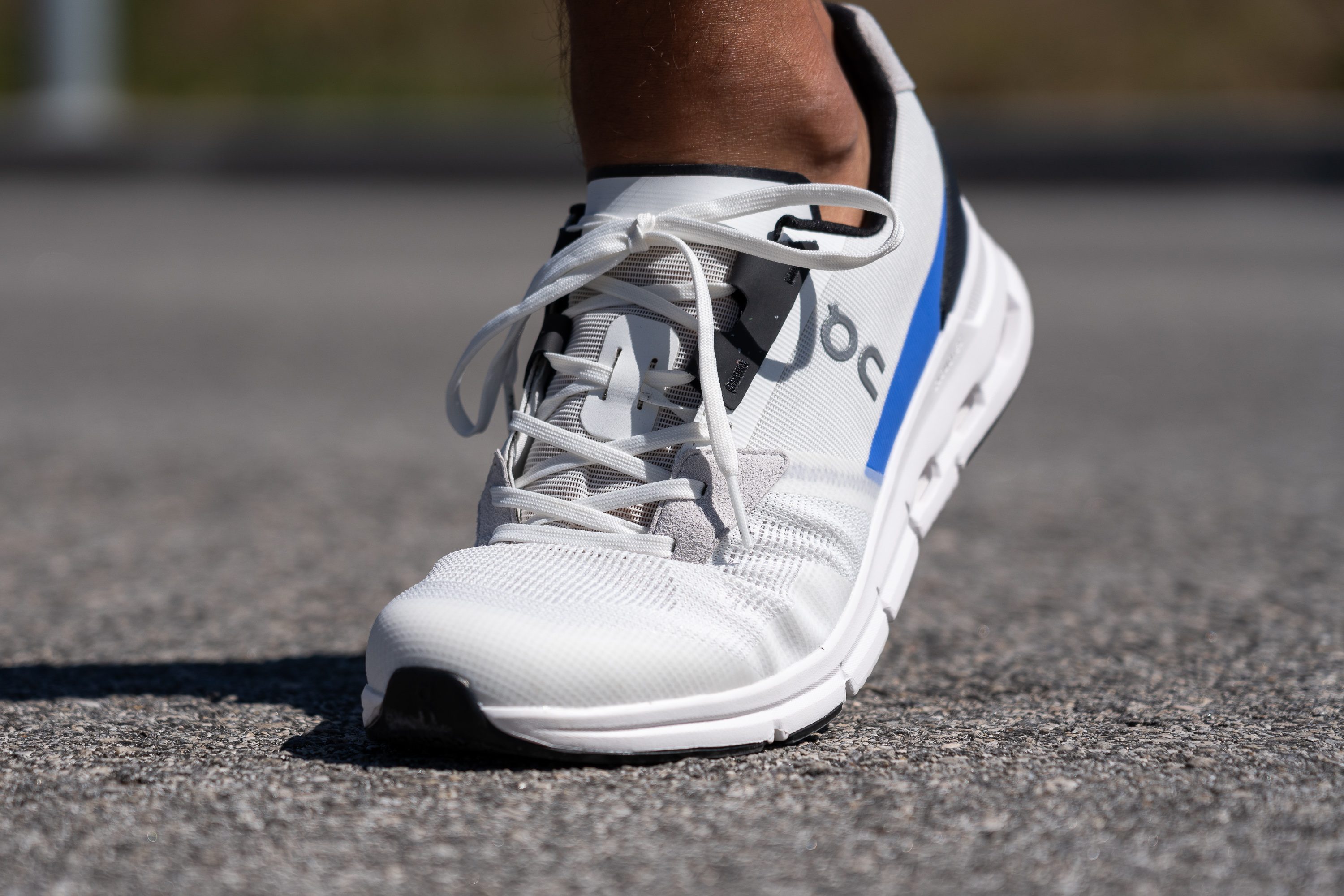Our verdict
Pros
- Super light on the foot
- Very flexible
- Highly breathable
- Springy and effortless ride
- Comfortable in-shoe feel
- Well-padded collar
- Reflective logos
Cons
- Very thin tongue that causes rubbing
- Really lacks durability
- Not a supportive shoe
Audience verdict
Comparison
The most similar walking shoes compared
+ + Add a shoe | |||||
|---|---|---|---|---|---|
| Audience score | 78 Bad! | 90 Great! | 88 Good! | 88 Good! | |
| Price | $150 | $140 | $150 | $150 | |
| Arch support | Neutral | Neutral | Neutral | Neutral | |
| Shock absorption | Moderate | Moderate | Moderate | Moderate | |
| Energy return | High | Moderate | Moderate | High | |
| Traction | High | Moderate | High | High | |
| Condition | - | Heavy personPlantar fasciitis | - | - | |
| Orthotic friendly | ✓ | ✓ | ✓ | ✓ | |
| Weight lab Weight brand | 8.7 oz / 247g 9.4 oz / 266g | 10.3 oz / 292g 10.3 oz / 292g | 7.6 oz / 215g 7.6 oz / 215g | 8.5 oz / 242g 8.6 oz / 243g | |
| Lightweight | ✓ | ✓ | ✓ | ✓ | |
| Breathability | Breathable | Breathable | Breathable | Breathable | |
| Use | TravelFitnessTreadmill | For standing all dayTravelWorkCityDisneyEuropeFitnessFor nursesTreadmill | TravelFitness | Travel | |
| Size | True to size | True to size | True to size | Slightly small | |
| Midsole softness | Firm | Firm | Firm | Firm | |
| Difference in midsole softness in cold | Small | Small | Small | Normal | |
| Insole thickness | Average | Average | Average | Average | |
| Removable insole | ✓ | ✓ | ✓ | ✓ | |
| Stiffness | Moderate | Moderate | Moderate | Moderate | |
| Torsional rigidity | Flexible | Moderate | Flexible | Moderate | |
| Heel counter stiffness | Flexible | Moderate | Flexible | Flexible | |
| Heel tab | None | None | None | None | |
| Drop lab | 9.9 mm | 13.1 mm | 7.8 mm | 7.1 mm | |
| Heel stack lab | 28.7 mm | 32.9 mm | 28.5 mm | 28.3 mm | |
| Forefoot | 18.8 mm | 19.8 mm | 20.7 mm | 21.2 mm | |
| Width / fit | Narrow | Medium | Medium | Medium | |
| Toebox width | Medium | Medium | Medium | Wide | |
| Closure | Laces | Laces | Bungee lacesLacesSlip-on | Bungee lacesSlip-on | |
| Toebox durability | Bad | Decent | Decent | Bad | |
| Heel padding durability | Bad | Decent | Decent | Bad | |
| Outsole durability | Decent | Good | Good | Good | |
| Midsole width - forefoot | Narrow | Wide | Narrow | Narrow | |
| Midsole width - heel | Average | Wide | Average | Average | |
| Outsole hardness | Average | Average | Hard | Average | |
| Outsole thickness | Average | Average | Average | Average | |
| Tongue padding | Very thin | Thin | Thin | Average | |
| Tongue: gusset type | None | Both sides (full) | Both sides (full) | Both sides (full) | |
| Collapsible heel | ✗ | ✗ | ✓ | ✗ | |
| Material | - | Mesh | Mesh | Mesh | |
| Ranking | #35 Bottom 2% | #18 Top 50% | #25 Bottom 30% | #23 Bottom 36% | |
| Popularity | #30 Bottom 16% | #13 Top 37% | #22 Bottom 38% | #28 Bottom 22% |
Who should buy
We recommend the On Cloudrift to people in search of the following:
- a walking shoe with style (contrasting colors and textures really make it stand out)
- a super lightweight, barely-there pair of shoes
- highly breathable footwear for summertime

Who should NOT buy
The tongue of the Cloudrift is practically paper-thin (only 0.5 mm). If you have sensitive skin around the ankle, we suggest going with the On Cloud 5 Push instead. It has a comfortable, well-padded tongue and collar.
Our lab tests also showed that the Cloudrift's upper really lacks wear resistance. If you tend to go through your daily-wear shoes too fast, it may be worth investing in the Cloudswift 3.
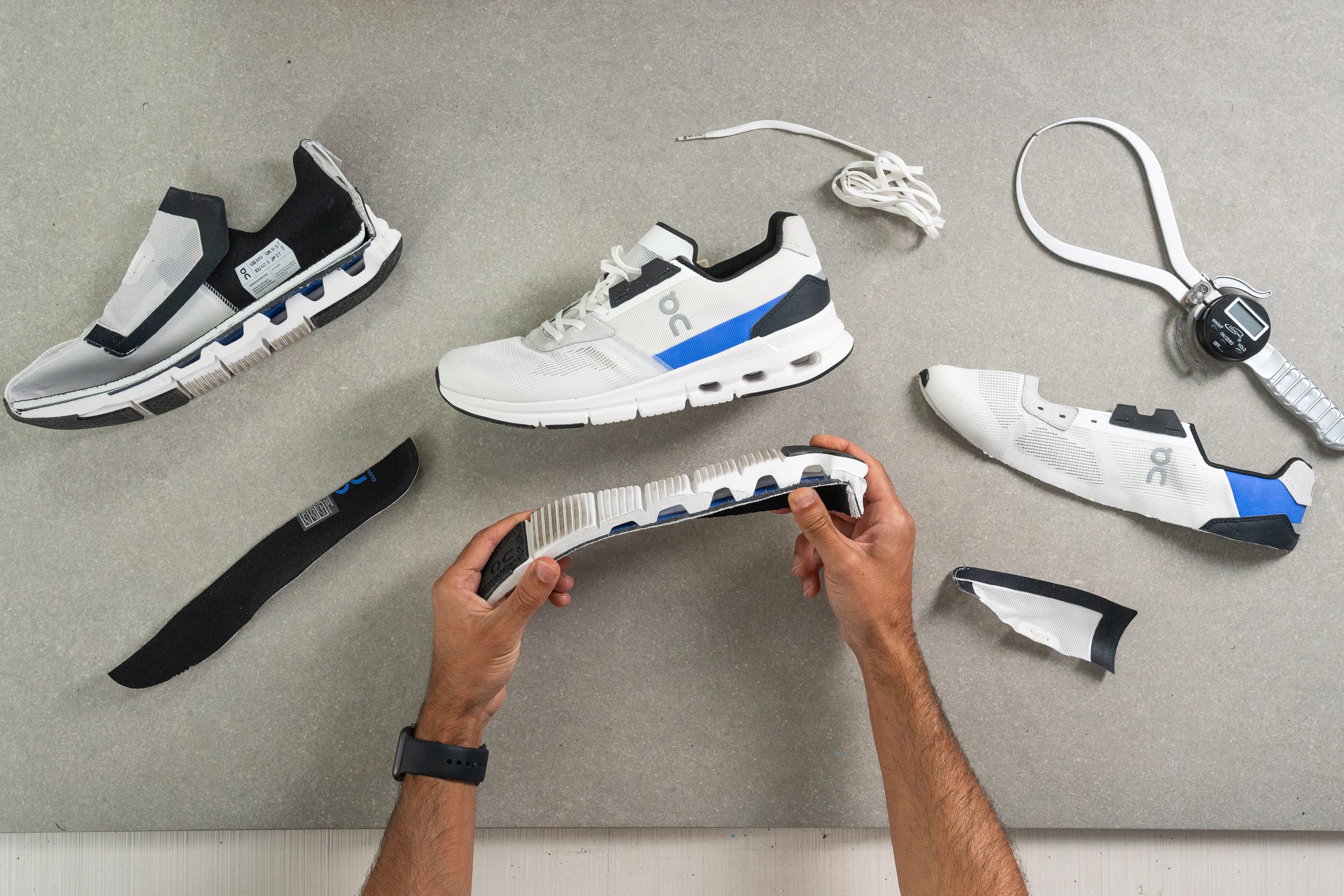
Cushioning
Shock absorption
The Cloudrift's grounded platform doesn't provide a ton of impact protection with a moderate shock absorption of 103 SA. However, it feels decently cushioned for a few hours of being out and about on hard concrete.
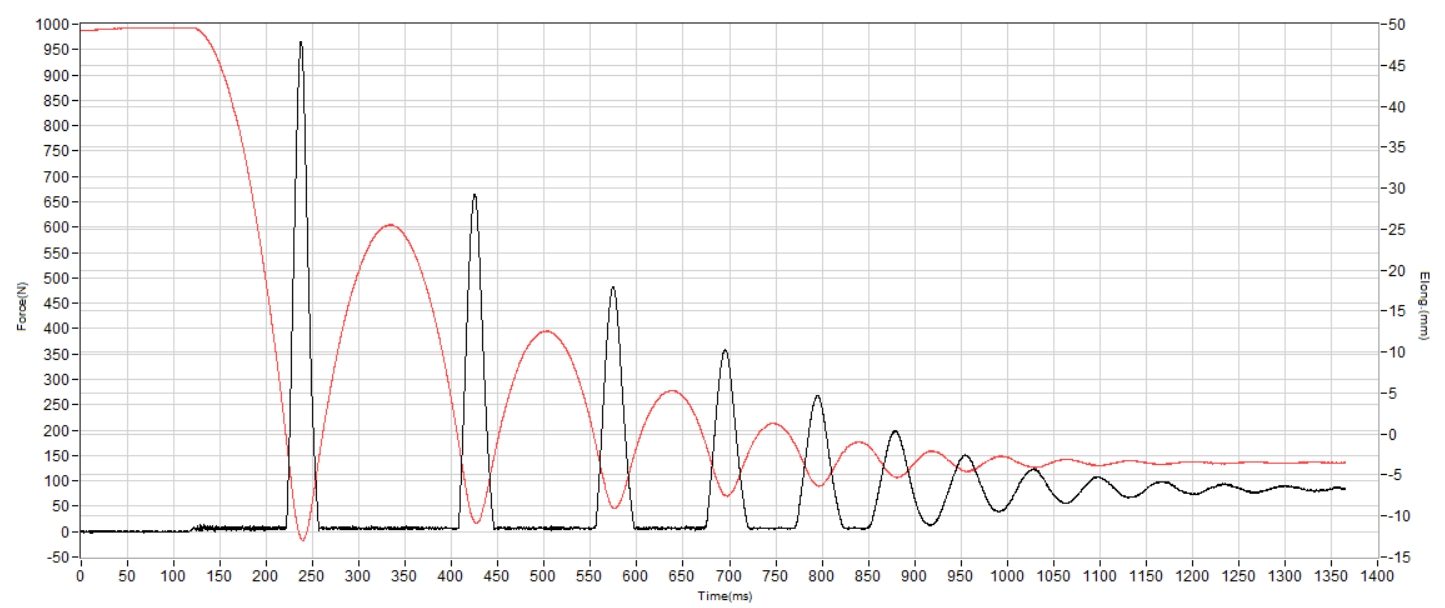
| Cloudrift | 103 SA |
| Average | 111 SA |
Energy return
The CloudTec cushioning and snappy Speedboard plate make the ride of this On shoe nice and dynamic. This springiness is reflected in the shoe's high energy return of 58.1%.
This responsiveness helps to compensate for some of the shoe's lacking shock absorption by easing stress on the feet and joints.
| Cloudrift | 58.1% |
| Average | 51.1% |
Heel stack
The Cloudrift is not one of the thickest shoes for sure, but we measured its stack height to be around the average of walking shoes. Our caliper shows 28.7 mm in the heel.
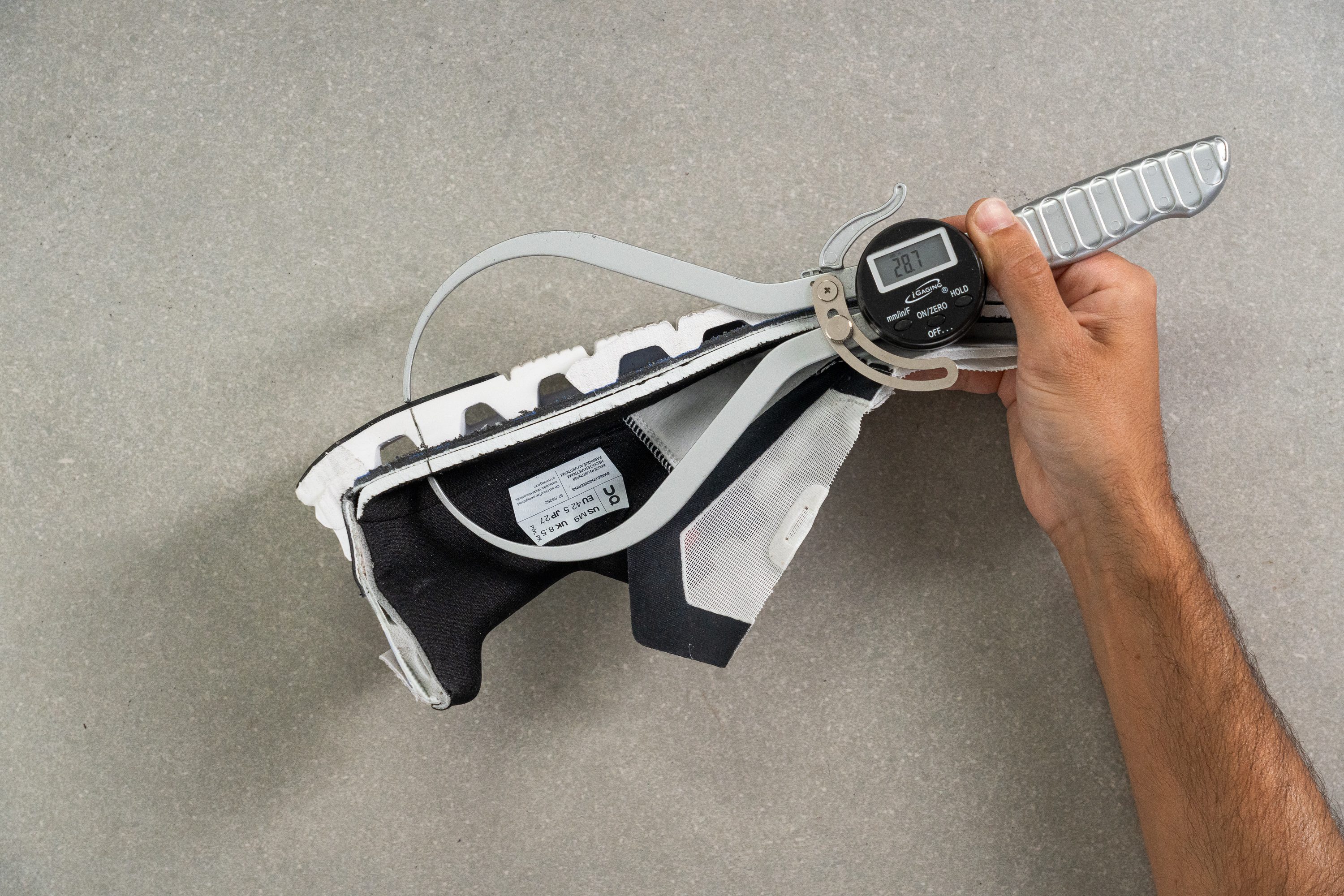
| Cloudrift | 28.7 mm |
| Average | 32.3 mm |
Forefoot stack
Measuring the forefoot, we found its stack height to be 18.8 mm, just a couple of millimeters thinner than the average.
We never felt as if we were lacking support under the toes.
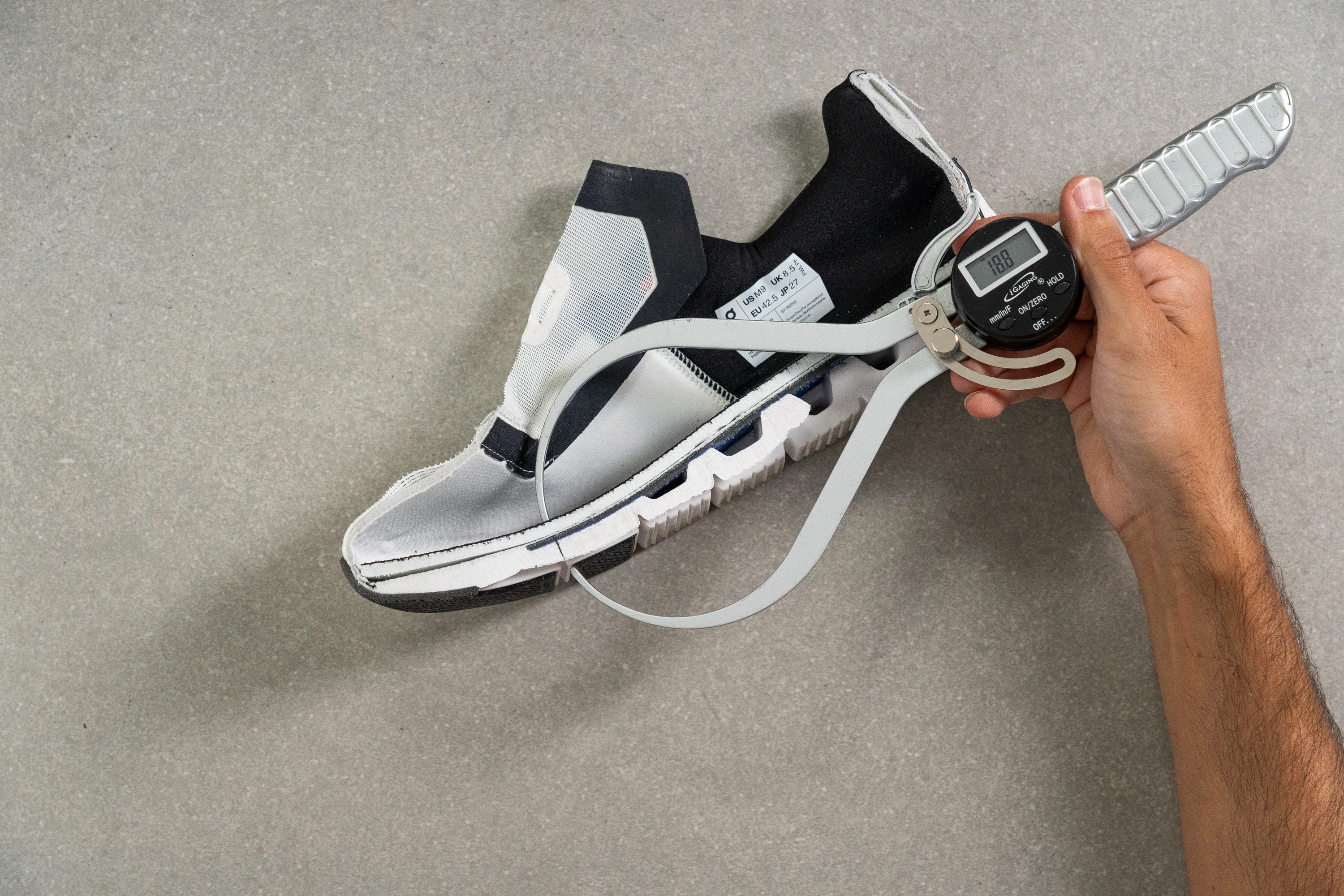
| Cloudrift | 18.8 mm |
| Average | 21.9 mm |
Drop
Calculating the difference between the heel and the forefoot, we found that the shoe's drop is 9.9 mm. This is exactly what's stated by the brand itself (10 mm).
We consider it to be a standard drop for walking shoes where the heel is noticeably elevated above the toes. This means that your feet are well protected from meeting the hard ground when stepping on the heels.

| Cloudrift | 9.9 mm |
| Average | 10.4 mm |
Midsole softness
We weren't surprised with how firm the Cloudrift felt underfoot. It is a shoe from On after all! We'd be amazed if it felt plush.
Pressing a durometer against the foam, we got a reading of 31.9 HA. This is 10% firmer than the average of our lab-tested walking shoes. In addition, there is a plastic Speedboard plate embedded into 2/3 of the midsole which contributes to the density.
We wouldn't call it a brick though. Just warning you that it is far from "walking on clouds."

| Cloudrift | 31.9 HA |
| Average | 26.4 HA |
Size and fit
Size
On Cloudrift fits true to size (43 votes).
Internal length
| Cloudrift | 267.2 mm |
| Average | 269.6 mm |
Width / Fit
We found the Cloudrift to be on the slimmer side of On's walking shoes and once the gel mold of its internal shape was ready, we understood why.
The widest part of the mold (which aligns with the metatarsal area of the foot) returned a notably narrower-than-average reading of 90.4 mm. We don't think people with wide feet and bunions would appreciate this fit but it's a nice option for those who do prefer next-to-skin kind of shoes.
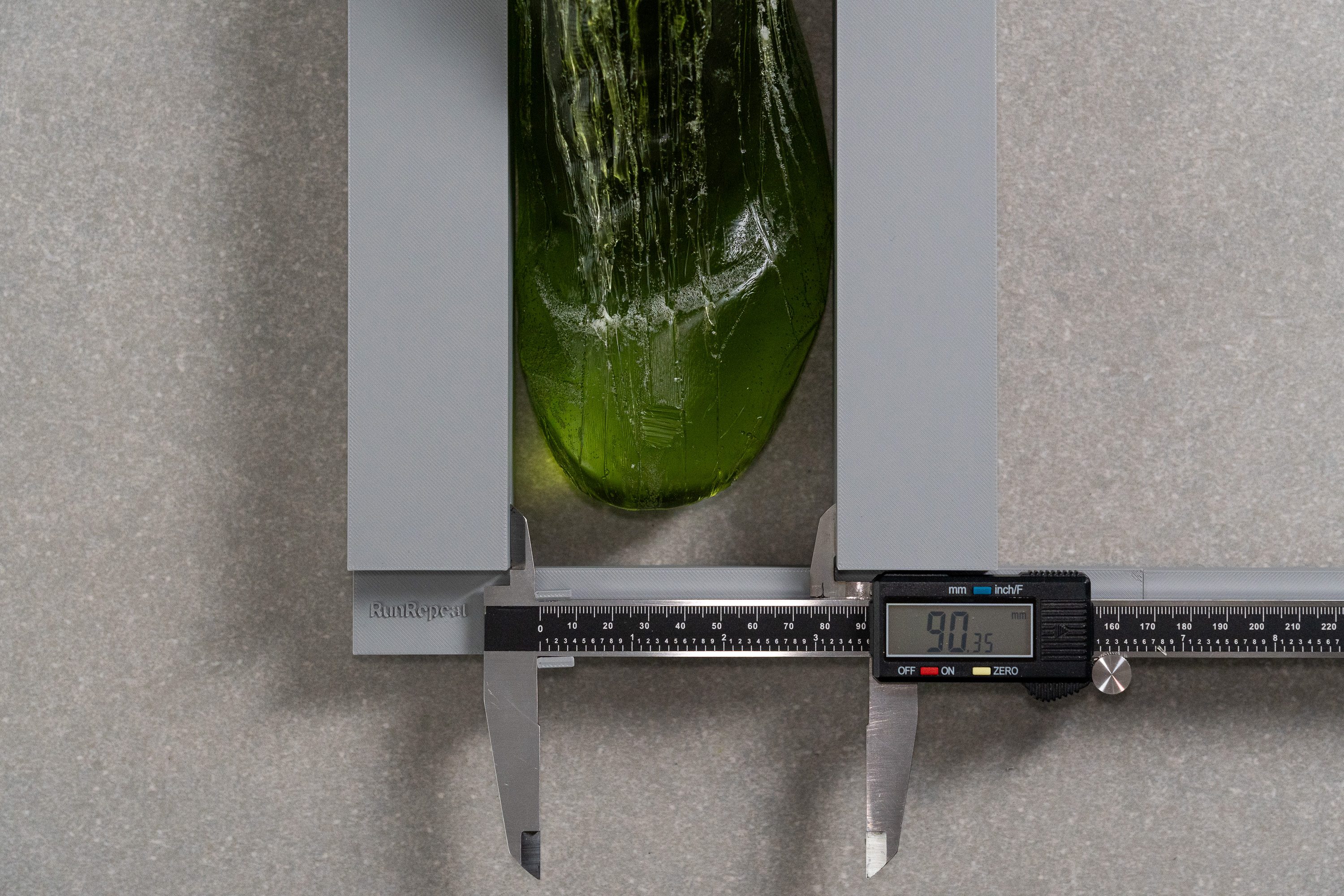
| Cloudrift | 90.4 mm |
| Average | 94.4 mm |
Toebox width
On the other hand, the Cloudrift doesn't get any narrower around the big toe than the average walking shoe. We measured the width here at 70.5 mm which is on par with the average.
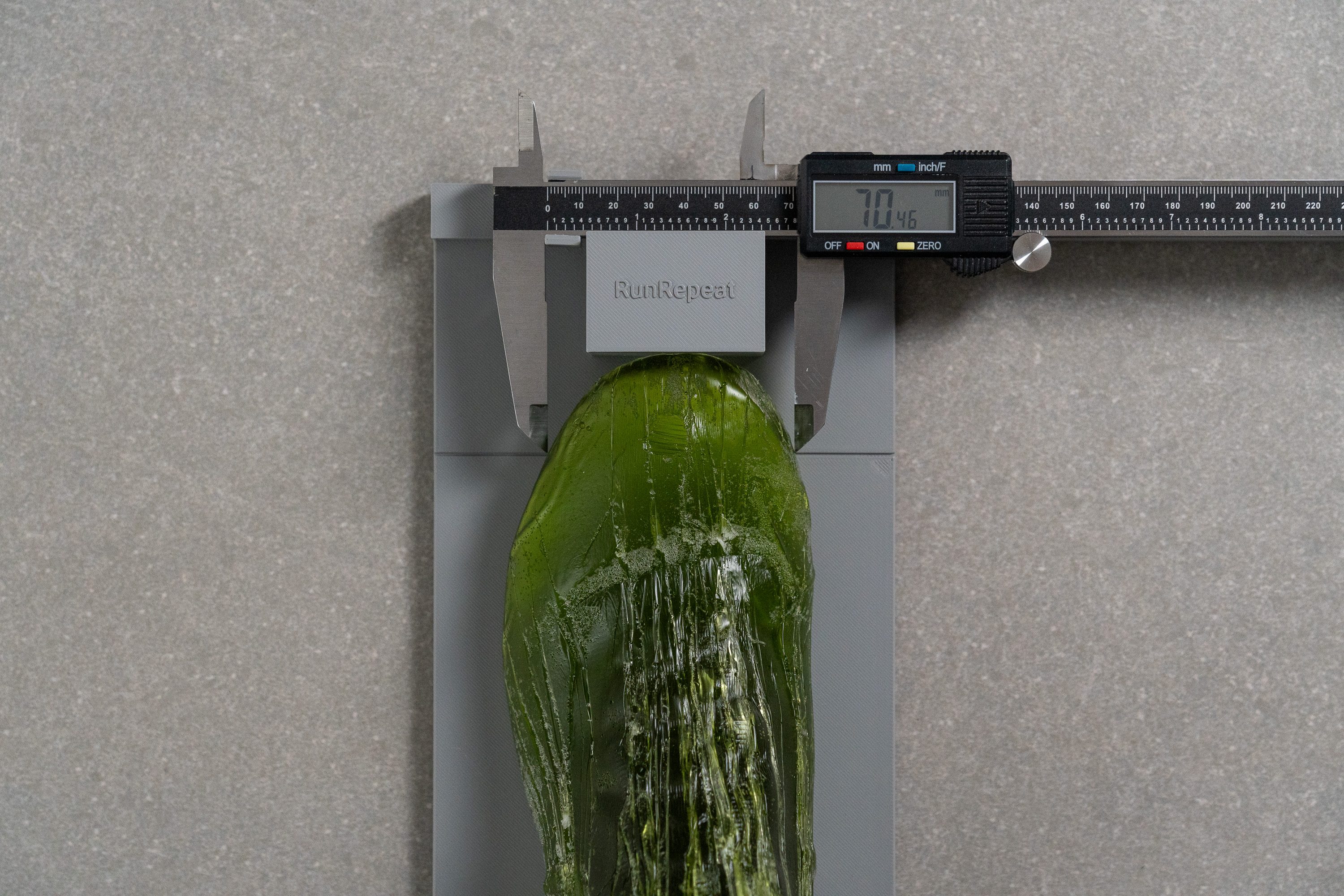
| Cloudrift | 70.5 mm |
| Average | 71.2 mm |
Toebox height
The vertical space of the Cloudrift also turned out to be within the norm for a D medium width at 25.5 mm.

| Cloudrift | 25.5 mm |
| Average | 26.4 mm |
Traction / Grip
Traction test
With no full-length outsole and lots of exposed foam, the On Cloudrift doesn't seem like your best bet for slippery slopes. But luckily, our controlled grip test showed the opposite.
The shoe's heel returned a solid coefficient of friction (0.45) as our machine performed a stomping action against wet concrete. The chosen force (500N) and shoe angle (7 degrees) helped to imitate a walking person's heel landing when the risk of slipping is the highest.
In other words, you can rely on the Cloudrift's traction on most dry and wet urban surfaces.
| Cloudrift | 0.45 |
| Average | 0.46 |
Outsole design
To keep the shoe's weight down, On added rubber only to the most high-wear areas of the Cloudrift - the heel and the forefoot. But it also added texture to the exposed foam to provide some grip in this area.
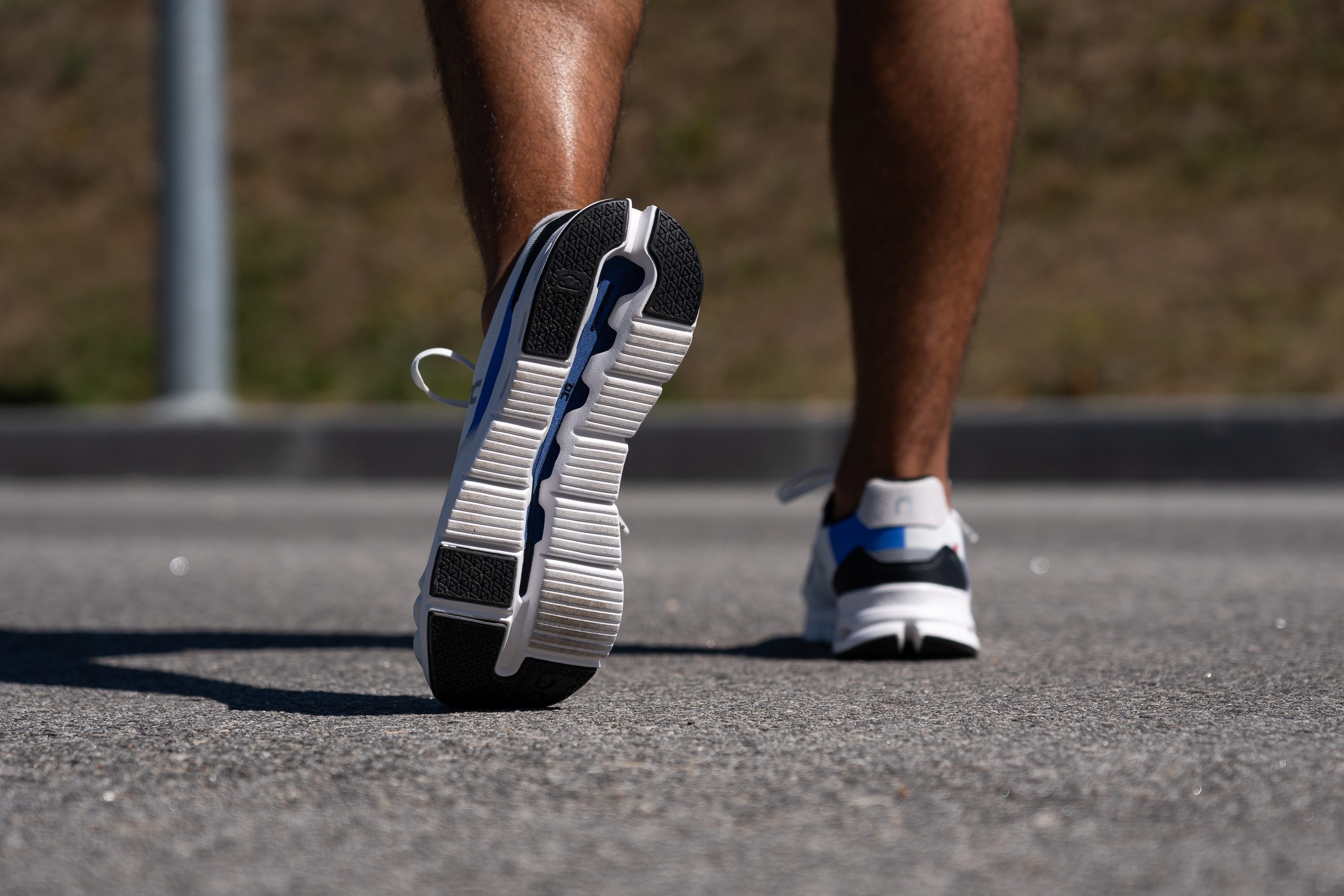
Flexibility / Stiffness
Performing our stiffness test with a specialized shoe flexing tester, we found that the Cloudrift is a pretty flexible shoe. And it certainly feels that way on the foot.
It only took 10.5N of ofrce to bend the shoe to a 30-degree angle, which is notably less than it takes a walking shoe on average.
Being able to bend our feet so naturally made us feel practically barefoot. Especially given how light this On shoe is.

| Cloudrift | 10.5N |
| Average | 13.9N |
Weight
One of the primary reasons to pick the On Cloudrift, in our opinion, is its weight.
Putting the shoe on our scale showed 8.7 oz (247g) in a men's US size 9, which is almost an ounce lighter than stated by the brand (9.4 oz/266g).
This is also lighter than most of our lab-tested shoes whose average weight is 9.2 oz (261g).
Walking all day in a lightweight pair of Cloudrifts surely left our feet and legs less fatigued!

| Cloudrift | 8.7 oz (247g) |
| Average | 10.2 oz (288g) |
Breathability
We can confidently recommend the Cloudrift as a summer walking shoe for its amazing breathability.
Using a smoke-pumping machine to check the permeability of the shoe's upper, we gave it a maximum rating of 5 out of 5. It allows plenty of smoke to pass through without obstruction.
As you can see from our transparency test below, there is a breathable mesh material all around the toebox and the tongue.
Taking an up-close look at the mesh through our microscope, we could see how the shoe manages to be so airy.
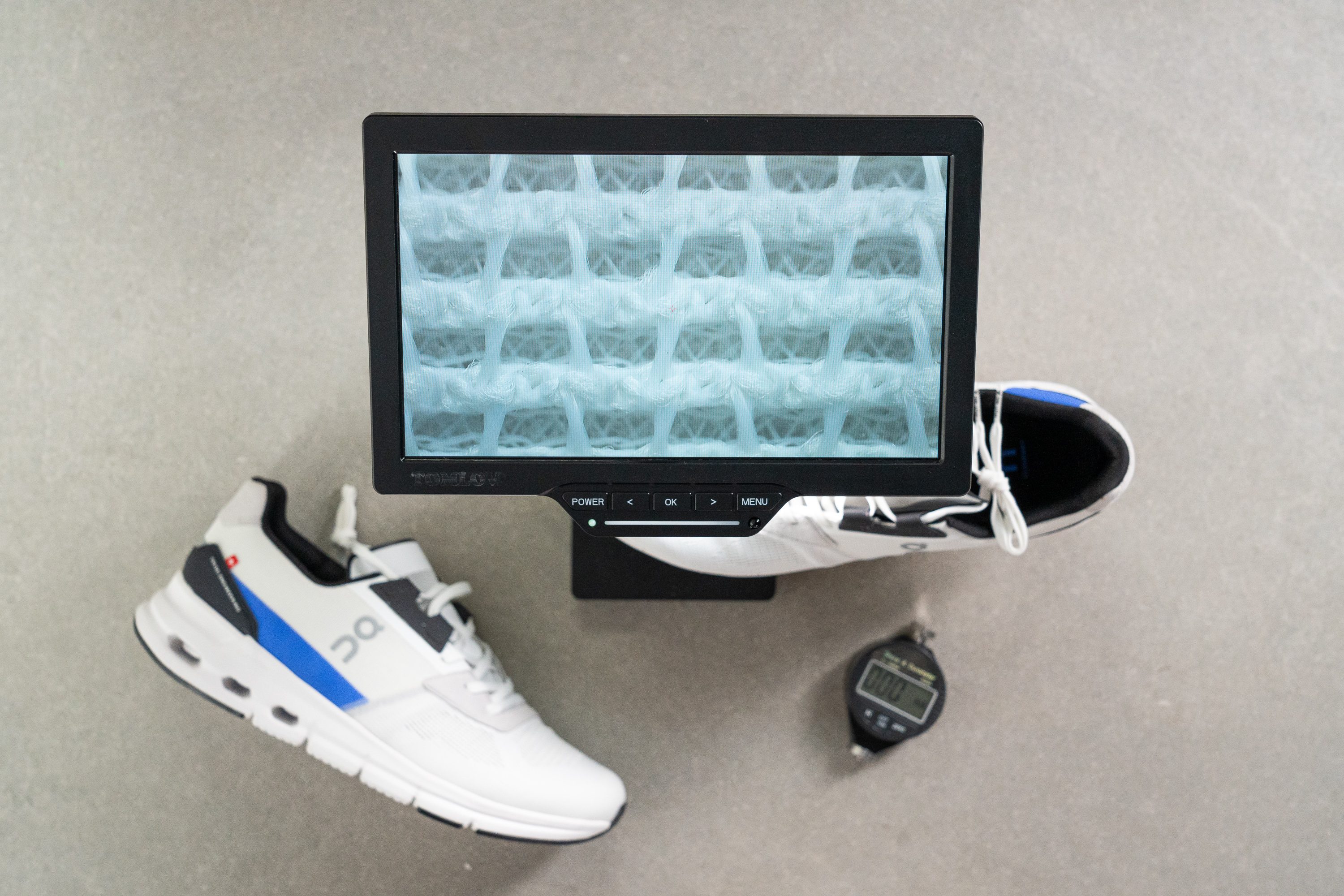
Despite having multiple layers, there is plenty of space in between the links for the air to pass through.
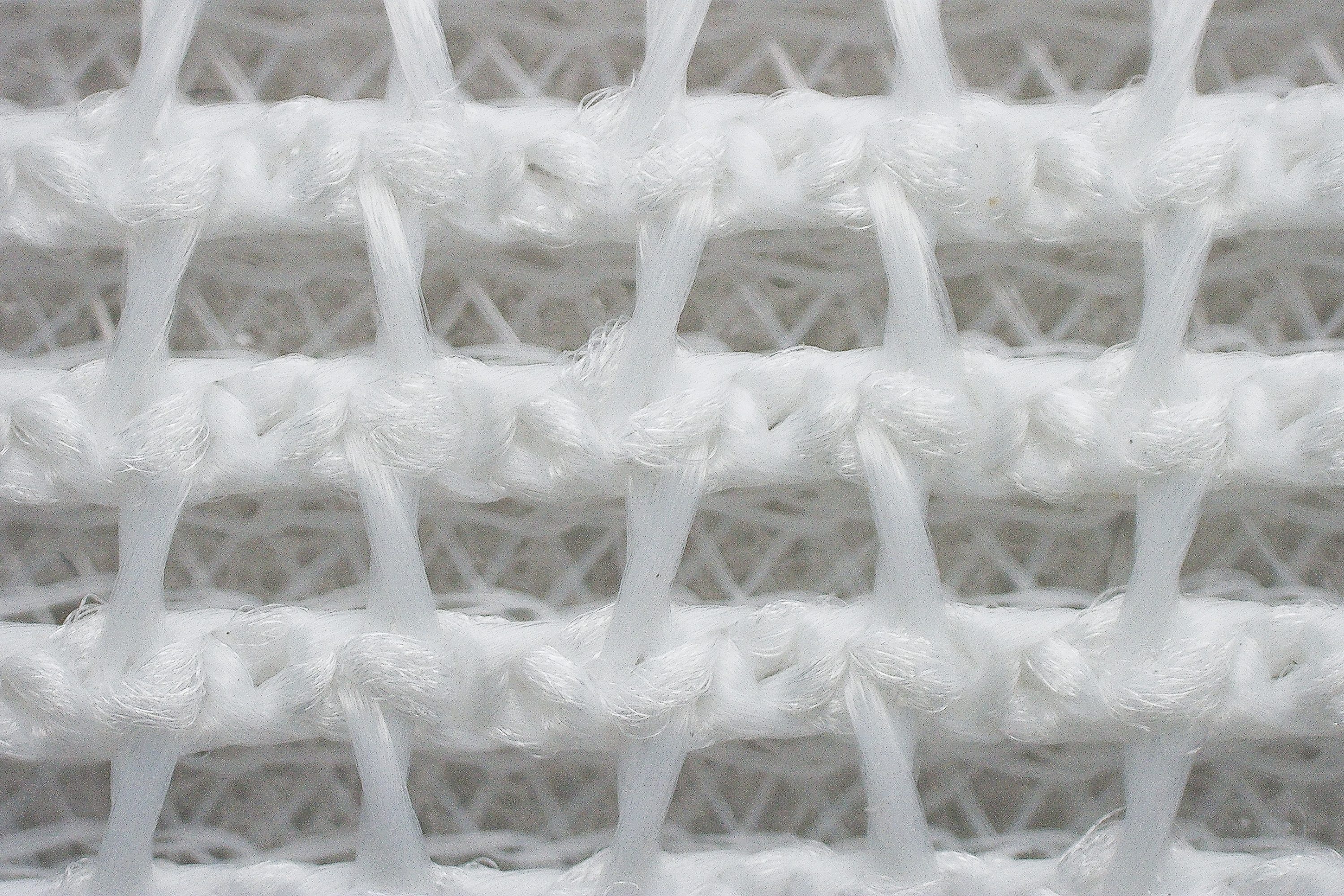
| Cloudrift | 5 |
| Average | 2.9 |
Stability
Lateral stability test
The On Cloudrift is not the most stable walking shoe in our catalog. Actually, we would even warn people with flat feet or overpronation from purchasing this one. There is simply not enough arch support to prevent the ankle from rolling inwards too much.
If you do need a shoe to meet these needs, we recommend the On Cloudnova Form instead.
Torsional rigidity
The Cloudrift gave in to our twisting test quite easily. There is a bit of stiffness to it which likely comes from the Speedboard plate. But it is only enough to bump its torsional rigidity up to 2 instead of 1 on a scale from 1 to 5.
The ride felt very natural and unobtrusive to us but this is definitely a red flag for people with stability needs.
| Cloudrift | 2 |
| Average | 2.9 |
Heel counter stiffness
We couldn't help but notice that the collar is more padded on the Cloudrift compared to other On shoes. It feels comfy against the Achilles but is not stiff enough to provide arch support for those who need it.
Pressing the heel counter, we rated its stiffness as 2 out of 5, which is only one point away from the most flexible measurement. For most folks, we consider it quite comfortable as the flexible collar wraps around the Achilles naturally, without dictating a fixed position for your ankles.
| Cloudrift | 2 |
| Average | 2.4 |
Midsole width - forefoot
The Cloudrift has a regular-sized sole, neither too narrow nor too wide.
We measured the widest part of the forefoot at 105.3 mm. This is about 4 mm narrower than the average. On the one hand, it helps to trim down the shoe's weight but on the other, it detracts from its overall stability.
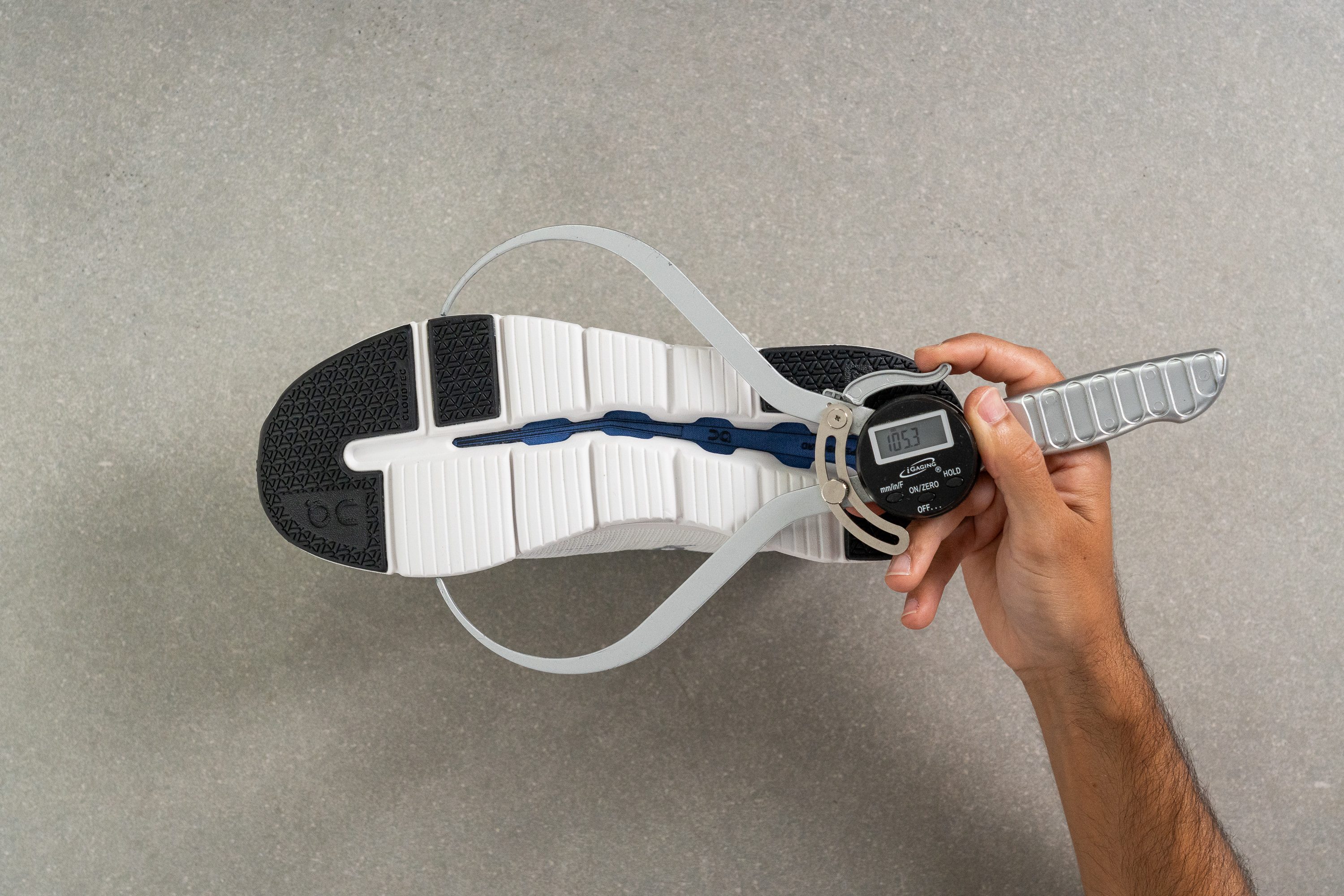
| Cloudrift | 105.3 mm |
| Average | 112.0 mm |
Midsole width - heel
In the widest part of the heel, our caliper shows 88.6 mm. This is a couple of millimeters wider than the average. Nothing to complain about.
Overall, we felt like the shoe's slightly narrower setup made it more light and nimble on the foot. However, people with flat feet should stay away from the Cloudrift.
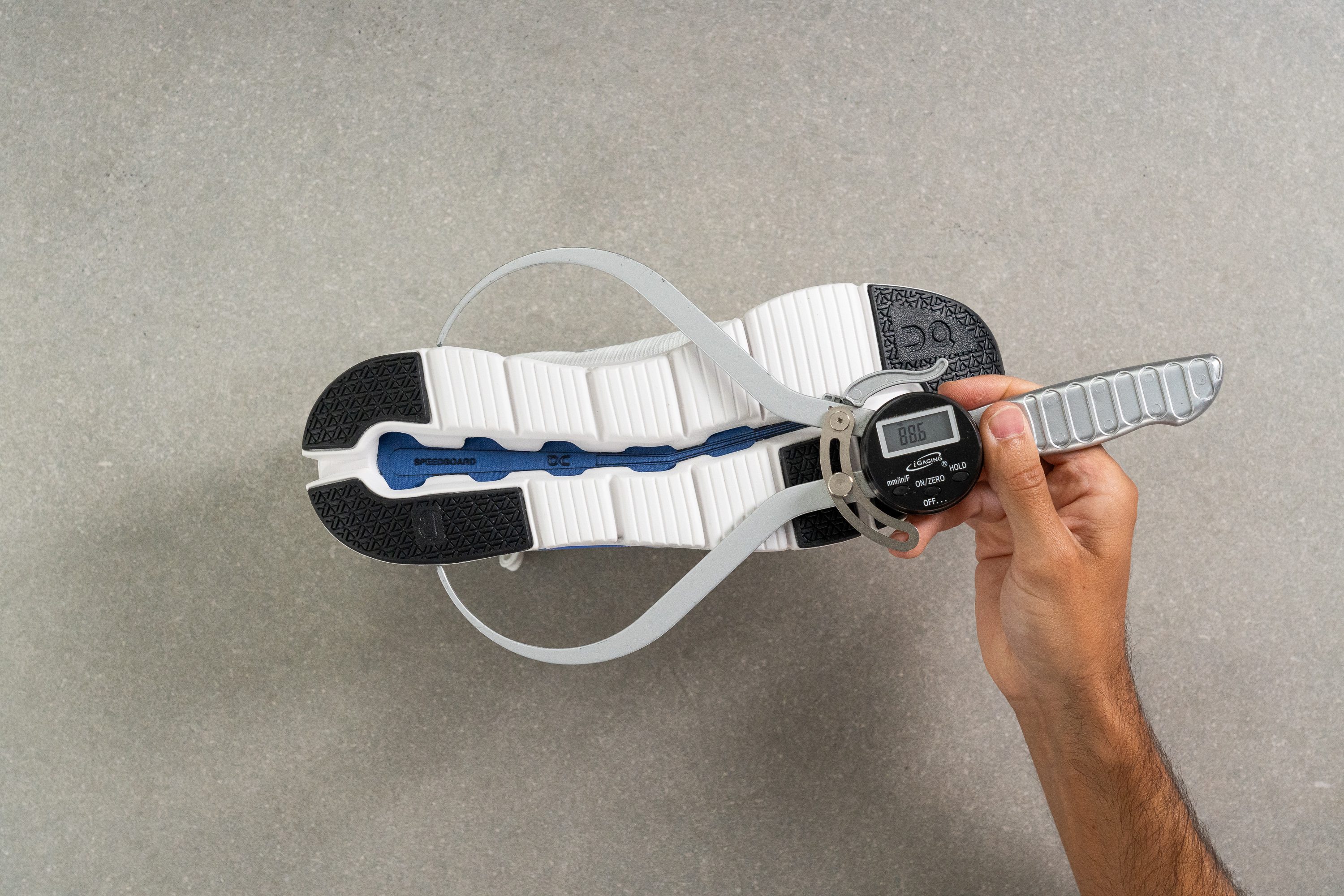
| Cloudrift | 88.6 mm |
| Average | 90.3 mm |
Durability
Toebox durability
Sadly, the shoe seems to sacrifice its upper durability to be so breathable.
As soon as our Dremel touched the mesh toebox, it caused serious damage. It took less than 4 seconds to wear through the material.
For that reason, we rated the Cloudrift's toebox durability as low as 1 out of 5.
| Cloudrift | 1 |
| Average | 3.2 |
Heel padding durability
Applying the same Dremel test to the shoe's heel padding, we observed the same amount of damage to the material.
The shoe gets another 1 out of 5 rating for wear resistance in the upper.
| Cloudrift | 1 |
| Average | 2.3 |
Outsole hardness
Looking at the bottom, we really don't expect it to last either. A large area of the sole is exposed, with no rubber coverage. Only the most high-wear areas in the forefoot and in the heel are protected.
So we went on to check how durable these rubber overlays are.
First, we pressed a durometer against the rubber to check how hard it is. Generally, we found that harder rubbers tend to last longer. Getting a reading of 83.5 HC, we were pleasantly surprised because it is a little harder than the average.
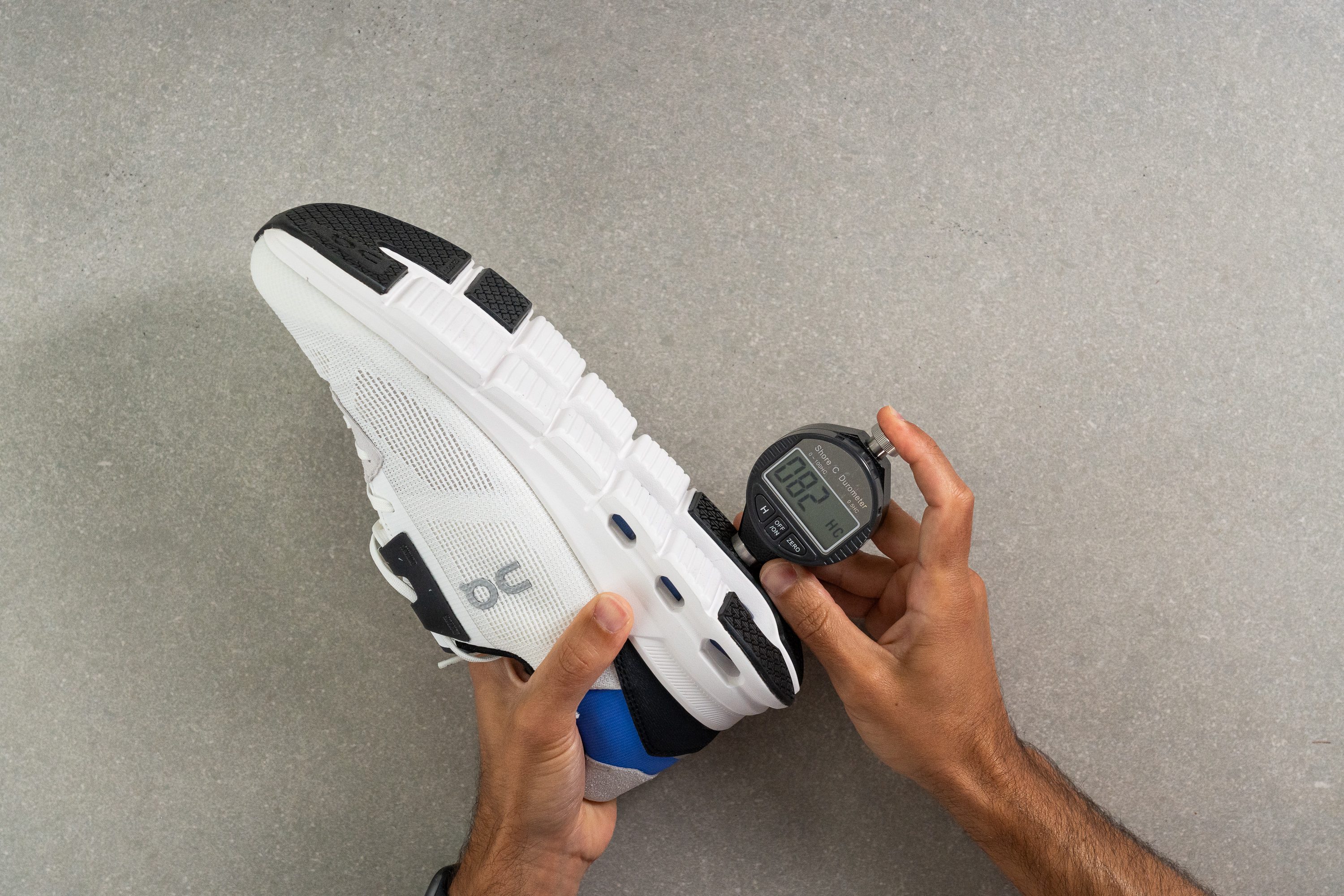
| Cloudrift | 83.5 HC |
| Average | 78.0 HC |
Outsole durability
But apparently, that hardness wasn't enough to minimize the abrasion caused by our Dremel.
Having applied the tool to one of the rubber pods for 22 seconds, it left a dent that was more than 1 mm deep.
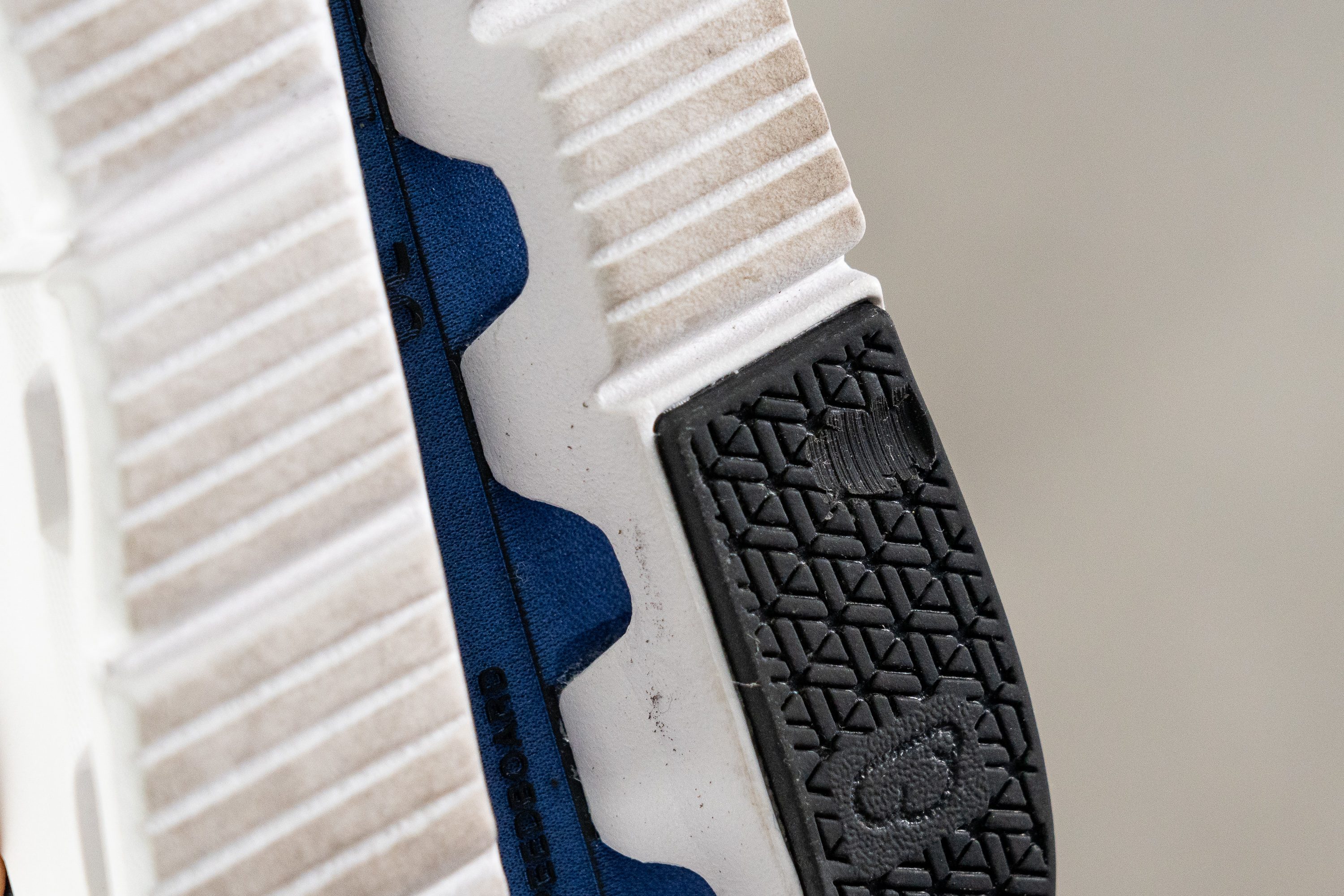
To be precise, we measured the depth of the dent with a tread gauge and got a reading of 1.2 mm. This is deeper compared to what we get on average.

| Cloudrift | 1.2 mm |
| Average | 1.4 mm |
Outsole thickness
Even the fact that the rubber pods on the Cloudrift are thicker than average didn't help to minimize the damage.
Using a caliper, we measured their thickness at 3.7 mm, more than 1 mm thicker than the average.
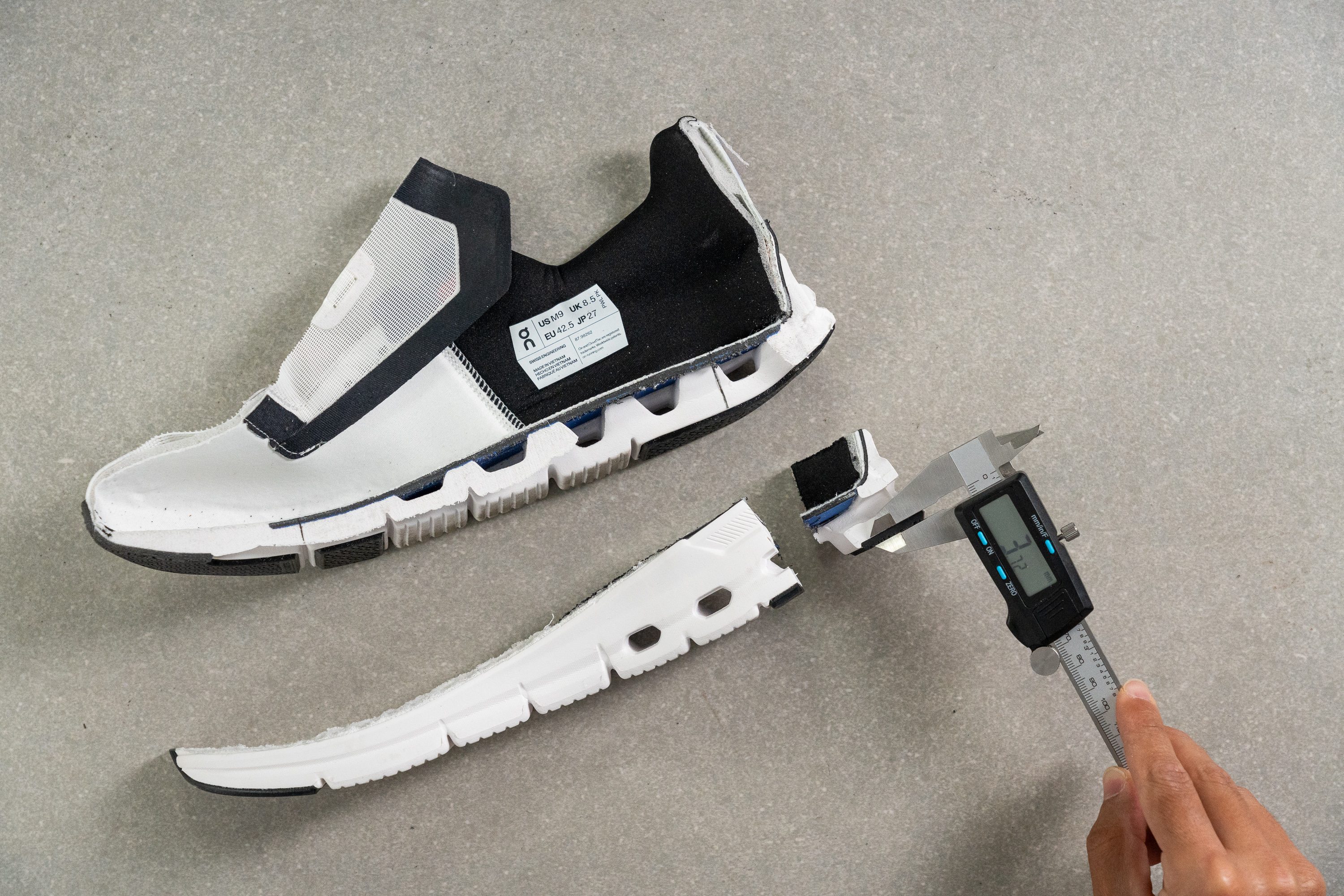
| Cloudrift | 3.7 mm |
| Average | 3.0 mm |
Misc
Insole thickness
The insole really helps to buffer the firmness of the sole. We measured it at 4.4 mm, which is a little thinner than the average 5.5 mm.
Yet, we didn't feel as if the padding was lacking in any way.
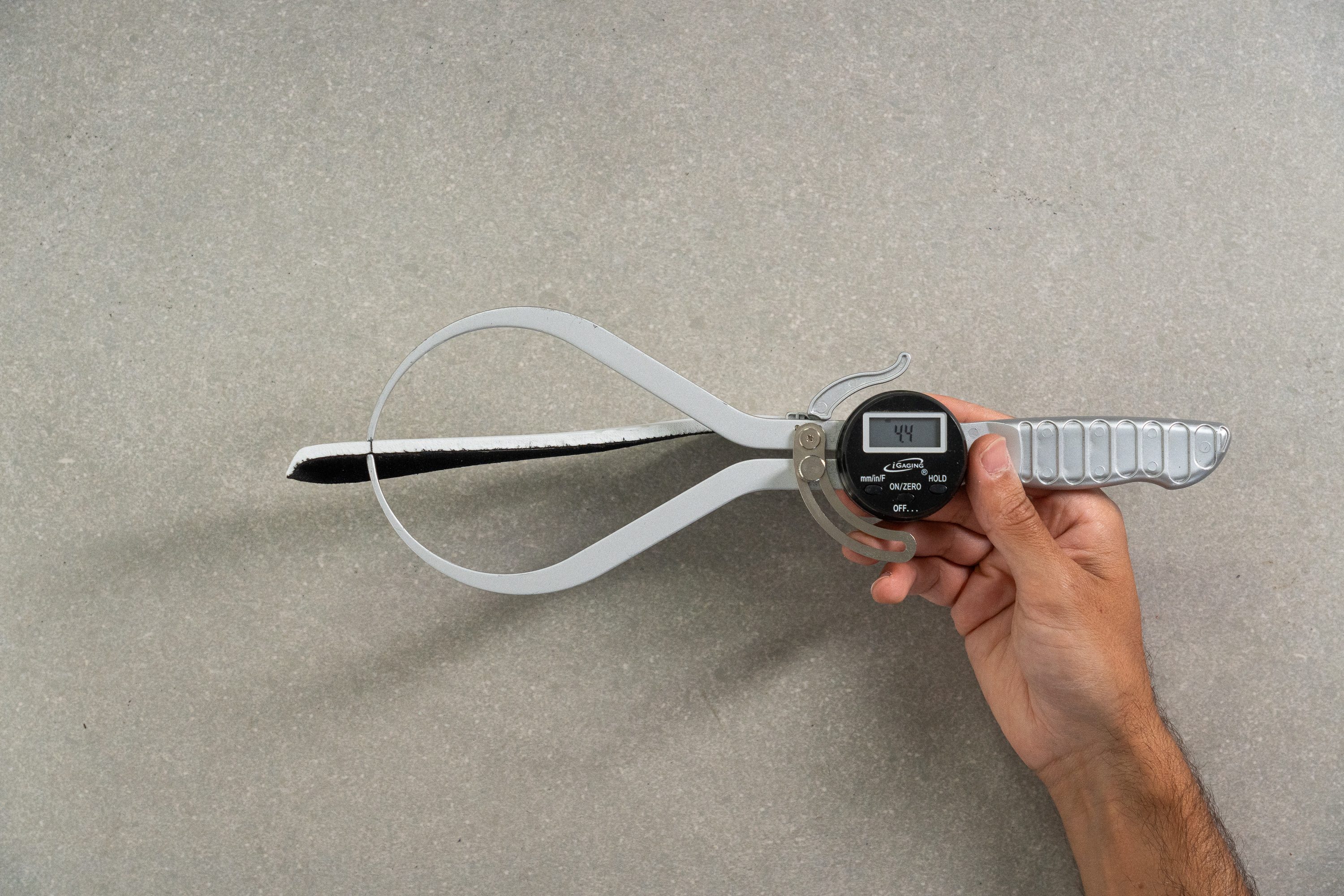
| Cloudrift | 4.4 mm |
| Average | 5.8 mm |
Removable insole
The Cloudrift comes with a removable insole. It is a nice bonus who those who want to wear a plusher custom insert to compensate for the firmness.
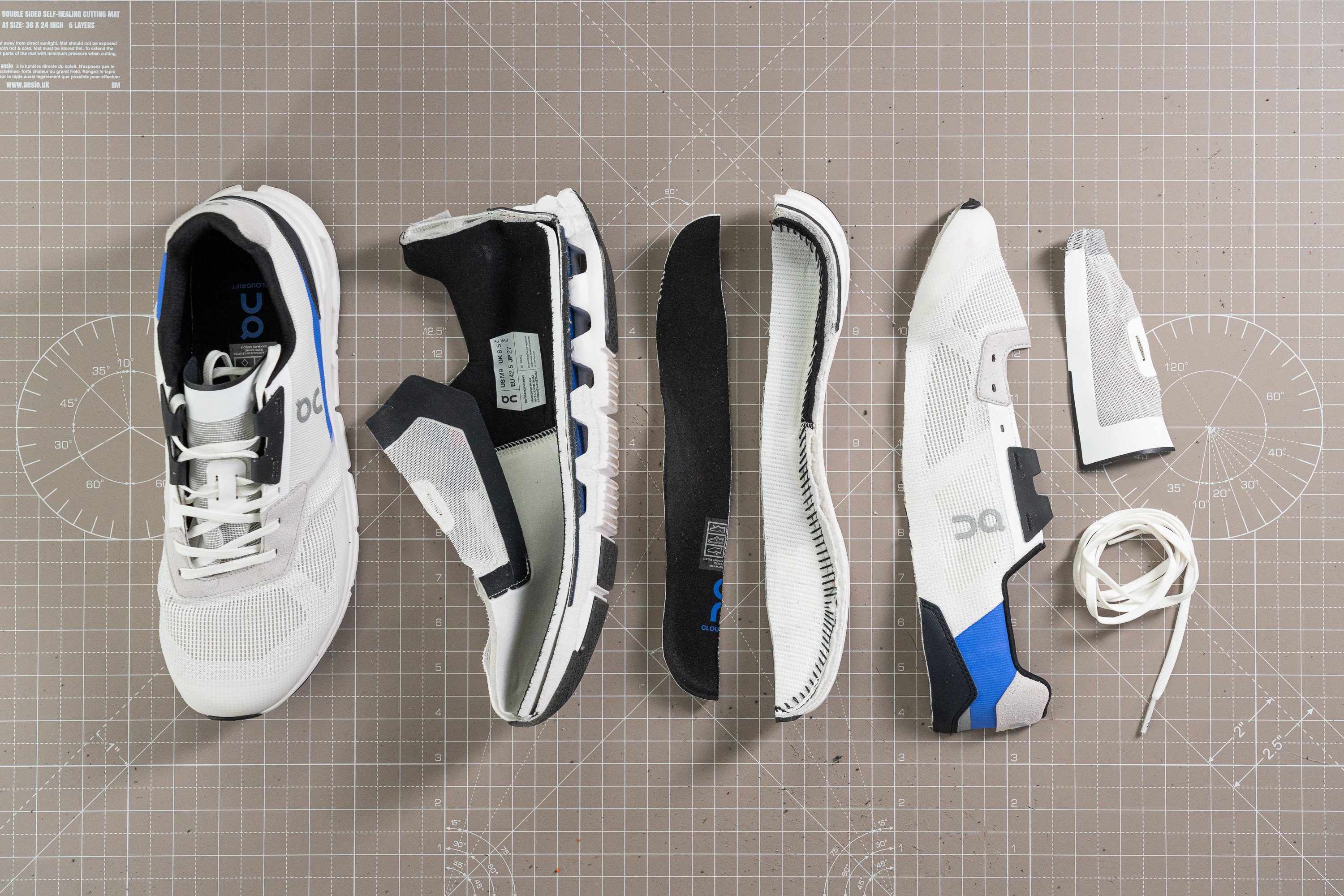
| Cloudrift | Yes |
This section is a work in progress
Midsole softness in cold (%)
On the bright side, wearing the Cloudrift on a chilly day won't make it that much firmer. We think that most wearers won't even notice the difference.
After keeping the shoe in the freezer for 20 minutes and repeating the measurement, our durometer showed 38.8 HA. Just as firm as the other walking shoes get after the same test.
Ironically, when exposed to a low temperature, the On Cloudrift only got 21.6% firmer. For comparison, walking shoes on average firm up by 36.5%.
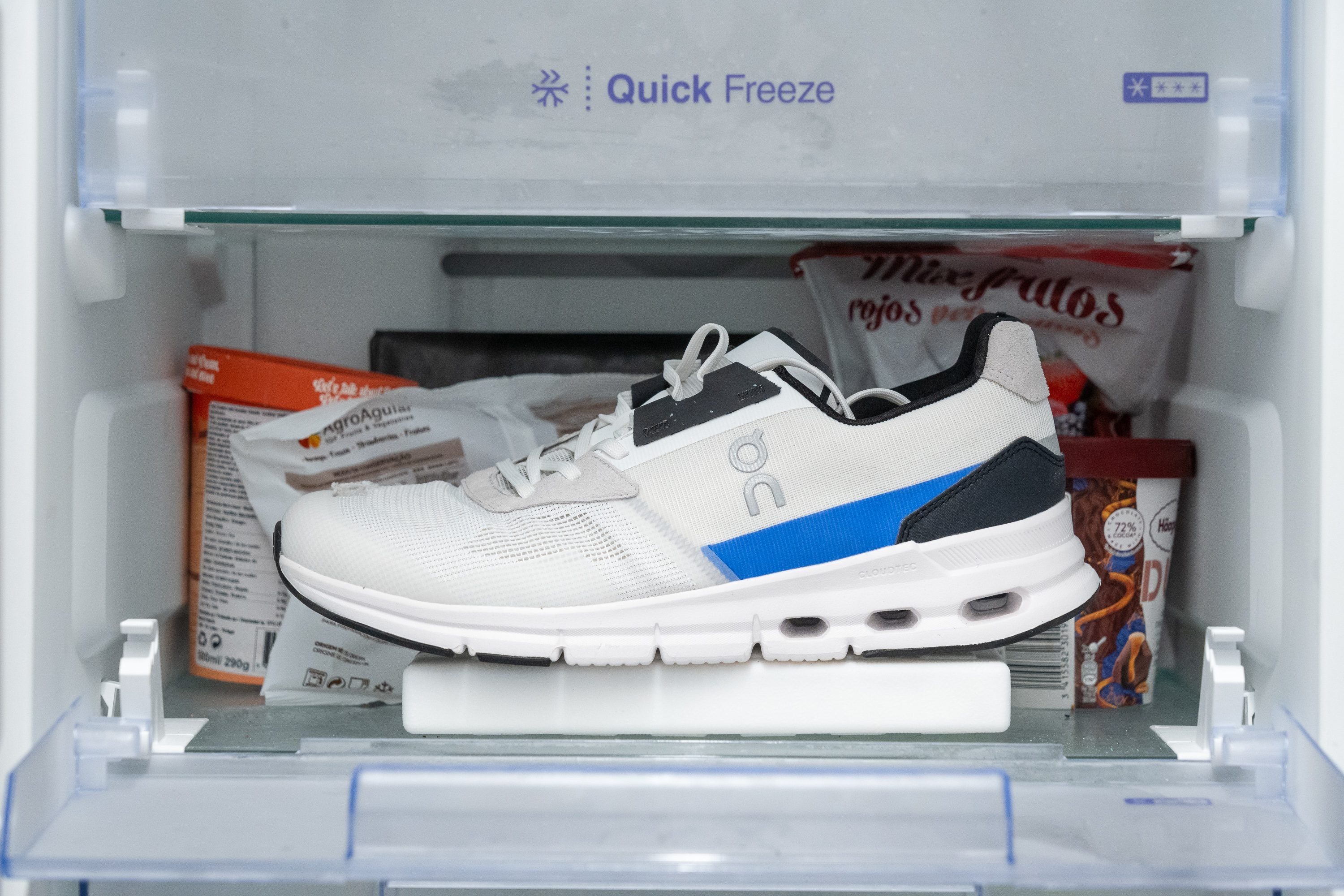
| Cloudrift | 22% |
| Average | 30% |
Reflective elements
The logos on the side and back are made of reflective material. A tiny bonus for those walking in the dark hours.

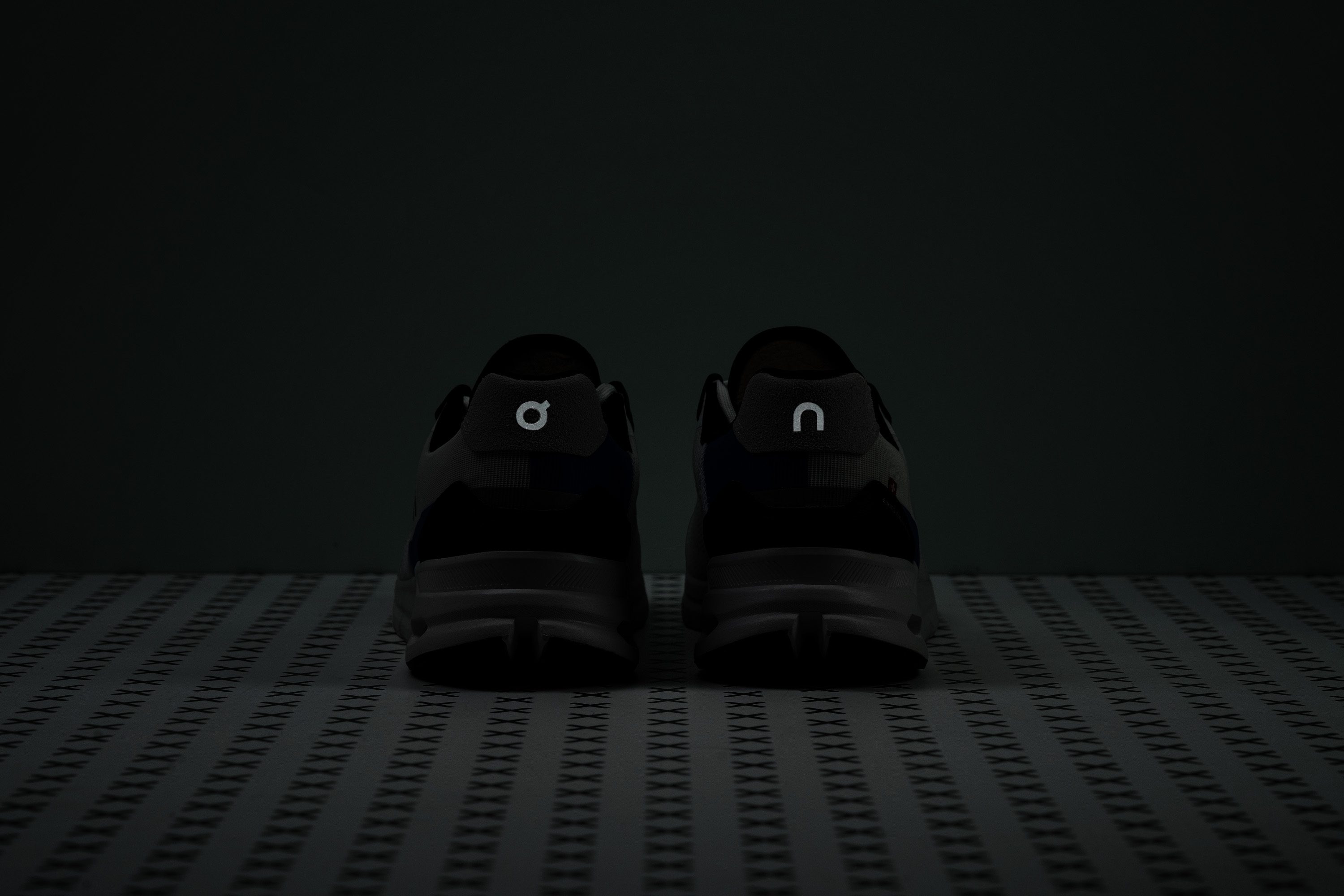
| Cloudrift | Yes |
Tongue padding
The tongue is insanely thin!
Using a caliper, we measured its thickness at only 0.5 mm. What's more, it is also quite oddly shaped and digs into the skin. We recommend wearing a taller (and maybe even thicker) sock with the Cloudrift for that reason.
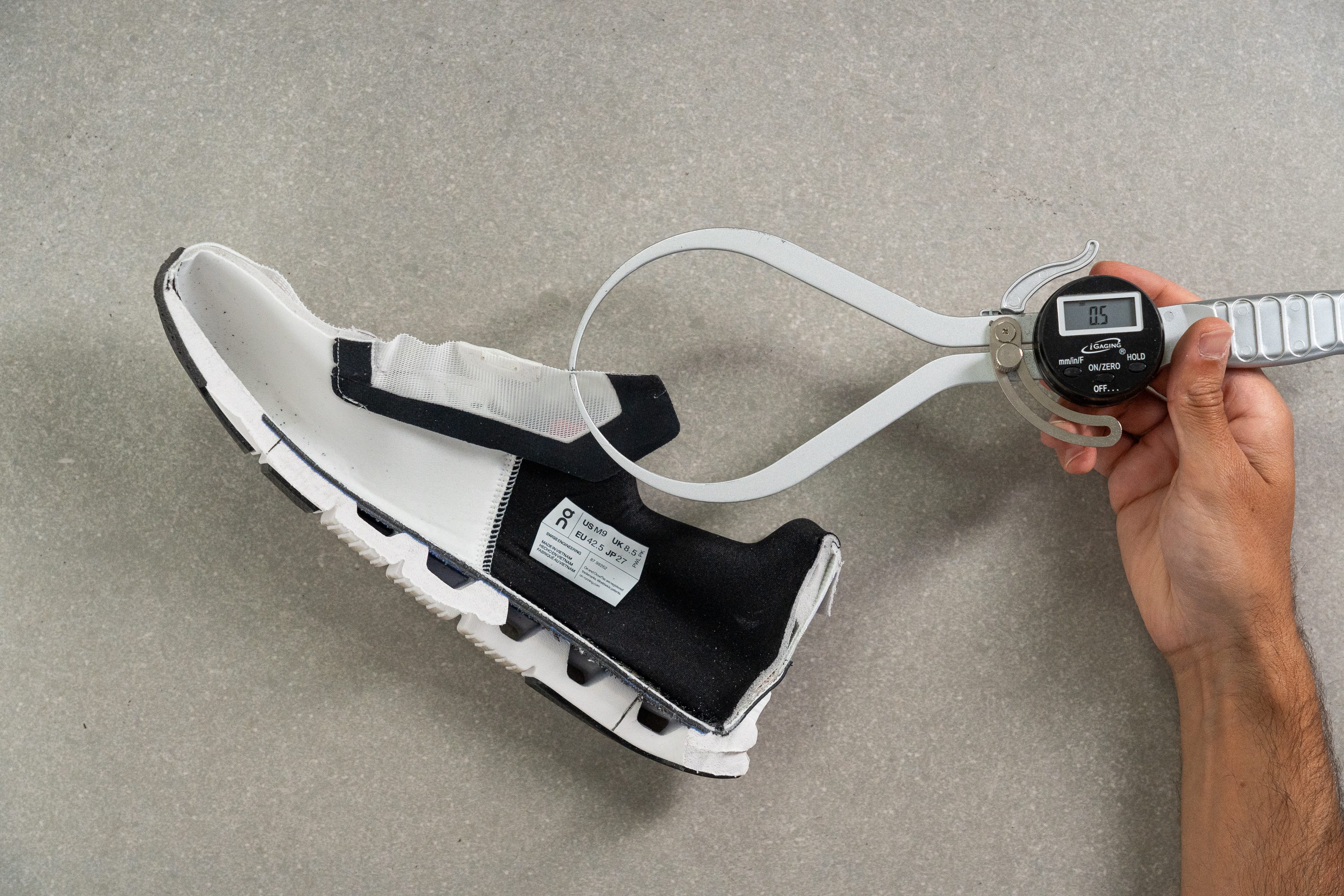
| Cloudrift | 0.5 mm |
| Average | 5.6 mm |
Tongue: gusset type
There are no gussets on the tongue, nor is it attached to the sides of the upper. This creates a bit of a problem for the Cloudrift given that the tongue is also super thin.
We were annoyed with the need to readjust it every once in a while. It has a tendency to move and bunch up.
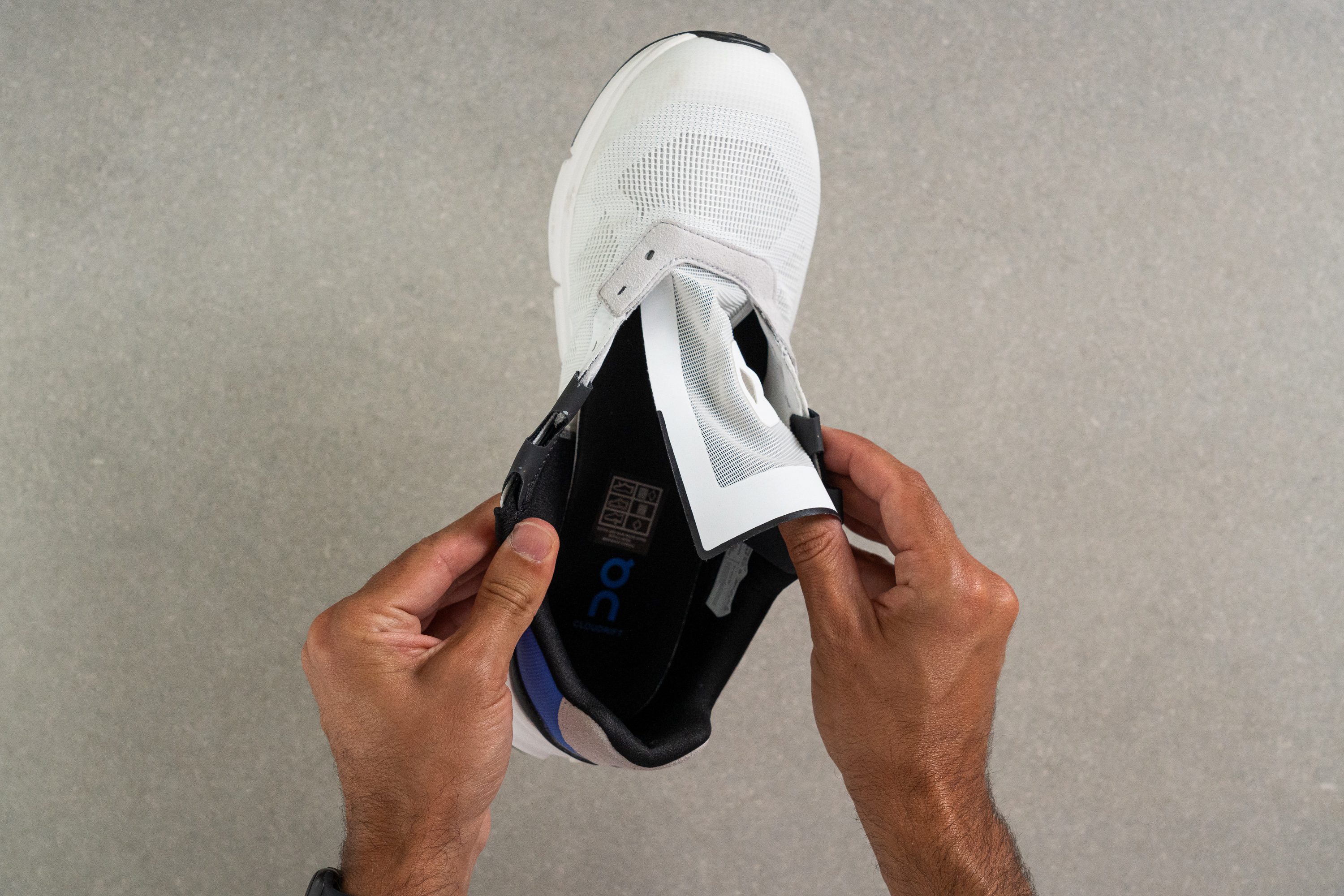
| Cloudrift | None |
Heel tab
There is no heel tab to hold on to when putting on the shoe. But the heel portion of the collar is quite high, so it can function as a pull tab in a way.

| Cloudrift | None |
Sustainable materials
The total recycled content in the On Cloudrift, according to the brand, is 35%.
Lacing
The photos on the brand's website can be misleading as they make the On Cloudrift look like a slip-on shoe. It is not! It comes with a pretty traditional set of laces.
But if you do want a slip-on shoe, we recommend the Cloud or the Cloud 5.
